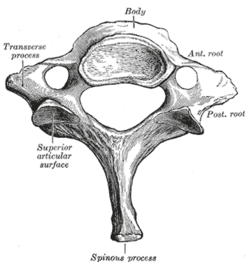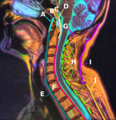| Nuchal ligament | |
|---|---|
 Muscles connecting the arm to the spine seen from behind (nuchal ligament labeled in red at center) Muscles connecting the arm to the spine seen from behind (nuchal ligament labeled in red at center) | |
 Seventh cervical vertebra Seventh cervical vertebra (spinous process visible at bottom) | |
| Details | |
| System | Skeletal |
| From | External occipital protuberance |
| To | Spinous process of cervical vertebra 7 |
| Identifiers | |
| Latin | ligamentum nuchae |
| TA98 | A03.2.01.006 |
| TA2 | 1678 |
| FMA | 13427 |
| Anatomical terminology[edit on Wikidata] | |
The nuchal ligament is a ligament at the back of the neck that is continuous with the supraspinous ligament.
Structure
The nuchal ligament extends from the external occipital protuberance on the skull and median nuchal line to the spinous process of the seventh cervical vertebra in the lower part of the neck.
From the anterior border of the nuchal ligament, a fibrous lamina is given off. This is attached to the posterior tubercle of the atlas, and to the spinous processes of the cervical vertebrae, and forms a septum between the muscles on either side of the neck.
The trapezius and splenius capitis muscle attach to the nuchal ligament.
Function
It is a tendon-like structure that has developed independently in humans and other animals well adapted for running. In some four-legged animals, particularly ungulates and canids, the nuchal ligament serves to sustain the weight of the head.
Clinical significance
In Chiari malformation treatment, decompression and duraplasty with a harvested nuchal ligament showed similar outcomes to pericranial and artificial grafts.
Other animals
In sheep and cattle, it is known as the paxwax. It relieves the animal of the weight of its head.
The nuchal ligament is unusual in being a ligament with an elastic component, allowing for stretch.
Structurally, the nuchal ligament is formed with the association of both elastin proteins as well as type III collagen (45%). The collagen fibrils share a consistent size as well as helical pattern which gives the ligament its tensile strength. The elastin on the other hand is a protein that allows for flexibility. These two elements of the nuchal ligament maintain a complex balance which allows the constant weight bearing of the head along with multidirectional movement without damaging the durability of the ligament through over-use/stretching.
In most other mammals, including the great apes, the nuchal ligament is absent or present only as a thin fascia. As it is required for running, not all animals have one.
All dogs (and all living Canidae - wolves, foxes, and wild dogs) possess a similar ligament connecting the spinous process of their first thoracic (or chest) vertebrae to the back of the axis bone (second cervical or neck bone), which supports the weight of the head without active muscle exertion, thus saving energy. This ligament is analogous in function (but different in exact structural detail) to the nuchal ligament found in ungulates. This ligament allows dogs to carry their heads while running long distances, such as while following scent trails with their nose to the ground, without expending much energy.
In horses, the parasite Culicoides can spread onchocerca cervicalis by living in the nuchal ligament, causing dermatitis.
Meat industry
In the meat industry, the nuchal ligament is referred to as paddywhack (also spelled pandywack; also called back strap or paxwax).
The word is mentioned in a dictionary of South-west Lincolnshire dialect as a synonym of paxwax (originally faxwax; Old English compound of "hair" + "to grow"). Hence, paddywack has been in use with this meaning since at least 1886.
Dried paddywhack is commonly packaged and sold as a dog treat. Paddywack is unpalatable as a human food because it cannot be softened or tenderised, but it makes a good natural dog chew. It is classed as offal by the meat industry.
Additional images
-
 I: Nuchal ligament
I: Nuchal ligament
-
 Occipital bone seen from outside (nuchal lines are identified at left)
Occipital bone seen from outside (nuchal lines are identified at left)
-
 Microscopic image of the nuchal ligament.
Microscopic image of the nuchal ligament.
See also
This article uses anatomical terminology.References
![]() This article incorporates text in the public domain from page 290 of the 20th edition of Gray's Anatomy (1918)
This article incorporates text in the public domain from page 290 of the 20th edition of Gray's Anatomy (1918)
- Drake, Richard L.; Vogl, Wayne; Tibbitts, Adam W.M. Mitchell; illustrations by Richard; Richardson, Paul (2005). Gray's anatomy for students (Pbk. ed.). Philadelphia: Elsevier/Churchill Livingstone. p. 45. ISBN 978-0-443-06612-2.
- ^ Swindler, D. R., and C. D. Wood. 1973 An Atlas of Primate Gross Anatomy. Seattle: University of Washington Press
- Cools MJ, Quinsey CS, Elton SW (April 2018). "Chiari decompression outcomes using ligamentum nuchae harvest and duraplasty in pediatric patients with Chiari malformation type I". J Neurosurg Pediatr. 22 (1): 47–51. doi:10.3171/2018.1.PEDS17670. PMID 29652242. S2CID 4793248.
- Merriam Webster Dictionary. Retrieved 4 October 2021.
- Virginia Studdert, Clive Gay, Douglas C. Blood, Saunders Comprehensive Veterinary Dictionary, p. 1252, Elsevier Health Sciences, 2011 ISBN 0702047449.
- Morocutti, M; Raspanti, M; Ottani, V; Govoni, P; Ruggeri (1991). "Ultrastructure of the bovine nuchal ligament". Journal of Anatomy. 178: 145–54. PMC 1260543. PMID 1810923.
- Bramble, Dennis M.; Lieberman, Daniel E. (2004). "Endurance running and the evolution of Homo" (PDF). Nature. 432 (7015): 345–52. Bibcode:2004Natur.432..345B. doi:10.1038/nature03052. PMID 15549097. S2CID 2470602.
- ^ Wang, Xiaoming and Tedford, Richard H. Dogs: Their Fossil Relatives and Evolutionary History. New York: Columbia University Press, 2008. pp.97-8
- Haussler, Kevin K.; Jeffcott, Leo B. (2014). "21 - Back and pelvis". Equine sports medicine and surgery : basic and clinical sciences of the equine athlete (2nd ed.). Edinburgh: Saunders. pp. 419–456. doi:10.1016/B978-0-7020-4771-8.00021-1. ISBN 978-0-7020-4771-8. OCLC 865010322.
- ^ Herzmann, Peter (2017). "It's all edible: Four views of offal". In McWilliams, Mark (ed.). Offal: Rejected and Reclaimed Food: Proceedings of the 2016 Oxford Symposium on Food and Cookery. Oxford Symposium. pp. 21–39 . ISBN 978-1-909248-55-7.
- "paxwax", Oxford English Dictionary Online, retrieved 10 October 2021 (subscription required).
- Robert Eden George Cole, A Glossary of Words Used in South-west Lincolnshire, English Dialect Society, 1886 OCLC 249538445.
- Ballard, Miranda (2021). Cluck, Oink, Baa, Moo. Ryland Peters & Small. ISBN 978-1-78879-395-7.
External links
| Joints and ligaments of torso | |||||||||||||||||||
|---|---|---|---|---|---|---|---|---|---|---|---|---|---|---|---|---|---|---|---|
| Vertebral |
| ||||||||||||||||||
| Thorax |
| ||||||||||||||||||
| Pelvis |
| ||||||||||||||||||